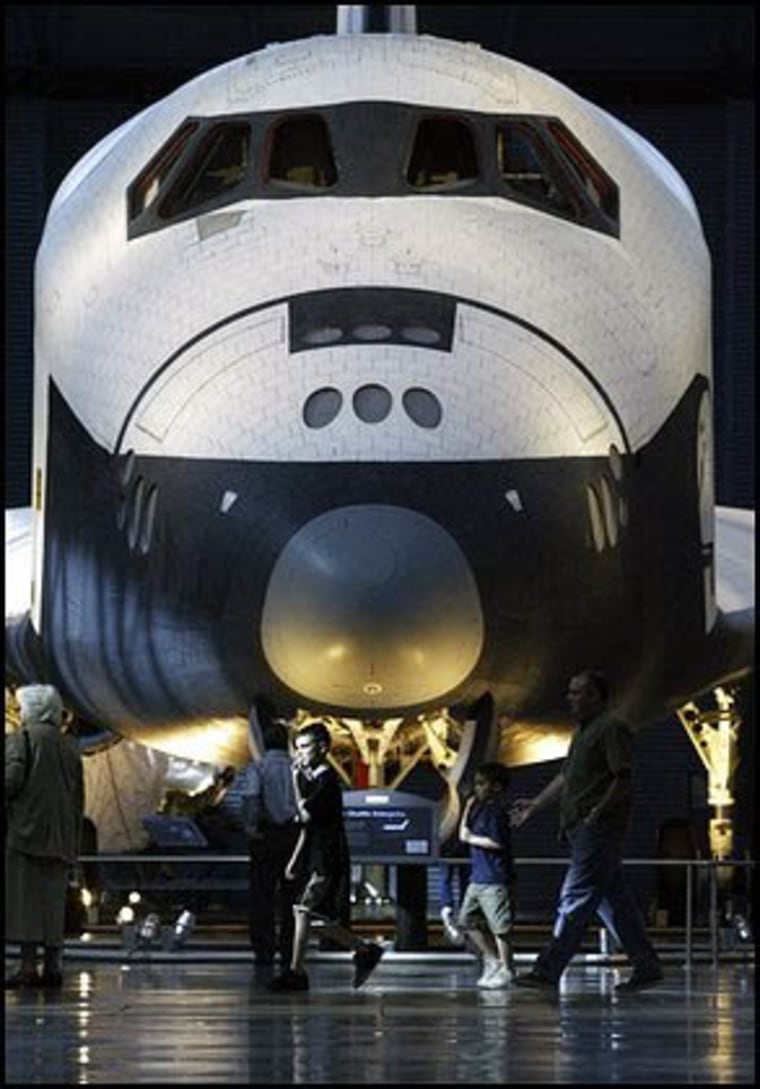Matthew Seu and his two sons yesterday became the first to boldly go where no tourist had been before: within a few feet of the spaceship Enterprise.
This was no movie prop. This was the real deal: A space shuttle, 122 feet long, able to carry a 150,000-pound payload, that once was capable of taking man beyond the blue. As Seu's wide-eyed sons put it as they took in the colossal sight: "Awesome."
"I've seen it on TV, but it looks much bigger in real life," said Seu, who lives in Ashburn.
Enterprise has been tantalizing space buffs since the National Air and Space Museum kicked off its new branch near Dulles International Airport in November 2003. About 1.7 million visitors have toured the popular center. But until yesterday, when the museum opened its cavernous James S. McDonnell Space Hangar, the shuttle's round, black nose and white face could be seen only from a distance.
About 60 people waited outside the main entrance before the doors opened at 10 a.m. to be the first to see the big ship. Seu's boys, 10 and 6 years old, beat everyone by bursting through the front doors and sprinting across what is the world's largest hanger.
When it was flight-ready in 1977, Enterprise, the first space shuttle, was flown on the back of an even larger plane. It got to the edge of the atmosphere but never quite made it into space.
Yet the craft was hailed as an important breakthrough and signaled a new era of space travel and exploration over the next two decades.
For all of its technological marvel, more work needs to be done to get Enterprise into mint condition.
About 60 woodpecker holes can be seen in the tip of the tail, apparently the work of hungry birds hunting insects that had burrowed into the foamy thermal tile during the ship's long storage, said Ed Mautner, who led the shuttle's renovation project.
And although the outside has a fresh coat of paint, the inside has plenty of cobwebs, empty birds' nests and dust. Mautner also noted that the leading edges of the shuttle's wings were taken away by NASA to help its investigation of the space shuttle Columbia's reentry breakup last year.
Also in hanger: Cruise missiles, satellites
There is plenty more to the space hangar beside its main attraction, museum officials say. Curators have collected cruise missiles and other rockets in one corner of the room. A history of satellites sits with Russian and U.S. prototypes in another.
One of the original Spacelabs has been set up near the shuttle's engines, while touch screens allow a glimpse into the ships' cockpits. Hanging from the ceiling is the jet-powered spacesuit that astronaut Bruce McCandless took out for a tetherless spacewalk off the deck of the shuttle Challenger in 1984.
A major theme of the collection is the contributions that the space program has made to everyday life, said Roger Launius, who chairs the division of space history for the museum.
Suspended above the space capsules, for instance, is the world's first hang glider, which NASA considered using as a landing mechanism before scrapping the idea.
"It's important to understand that hang gliding didn't really exist 40 years ago," Launius said. "It was really made possible by . . . NASA."
The collection is largely reminiscent of the golden age of space exploration in the 1960s and 1970s. (It even has a collection of space toys and lunchboxes that were popular in that era).
To that end, the museum evoked a lot of memories for sightseers who lived through those decades, even as it inspired younger generations to ponder a career in the stars.
Kerry Whitney, 33, of Ashburn brought her son Timothy, 3, because he is a fan of anything to do with space and loves watching a DVD of the Apollo 11 landing on the moon. For Halloween, he was, of course, an astronaut.
Anthony Maestri, 73, of Madison, Va., said the collection of satellites brought back the days after the Soviets launched Sputnik, the first satellite.
The collection also had personal significance for him: Maestri was one of the engineers who designed and developed the radio antennas for the space capsules.
And as he walked through the displays with his wife, sure enough, he spotted his contribution to the space program: a five-inch round piece of bright metal on the outside of the Mercury capsule that allowed astronauts in space to talk to Earth decades ago.
"We designed it round, so it could receive a signal from all directions," he said, beaming with pride.
"Everybody pooh-poohs the space program," he added. "But it did a lot of good, and I hope we don't abandon it."
